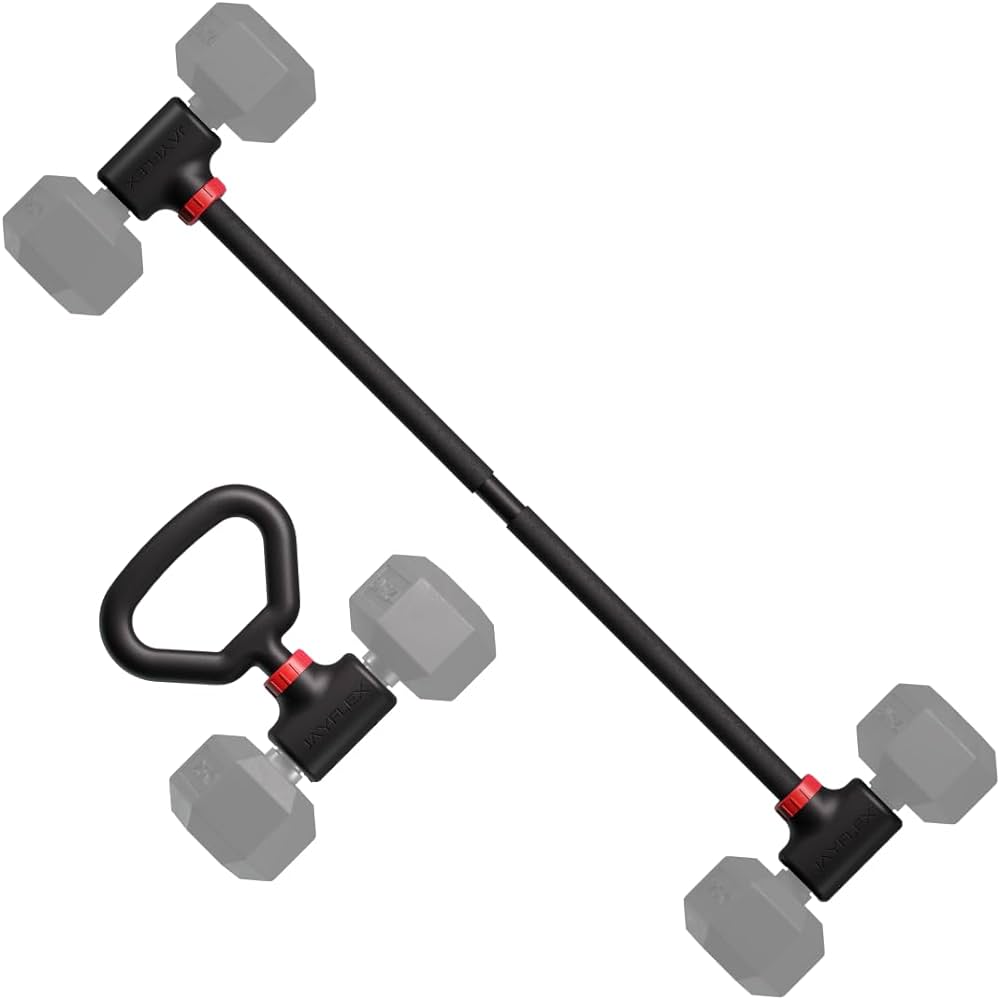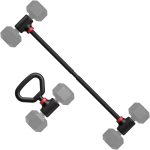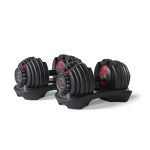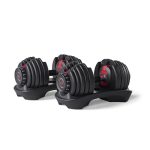Learn how to turn dumbbell into barbell easily with a dumbbell connector. Securely attach two dumbbells for a versatile weightlifting solution in your home gym.
Transforming your dumbbells into a barbell offers versatility in your workout routine. A dumbbell connector allows you to perform barbell exercises without purchasing a separate barbell. This innovation is perfect for home gyms with limited space and budget constraints. These connectors are easy to use and provide a secure hold, ensuring safety during workouts.
By connecting two dumbbells, you can replicate the experience of using a barbell, enhancing your strength training regimen. This method is not only cost-effective but also space-saving, making it ideal for fitness enthusiasts looking to maximize their home gym equipment.

Credit: www.amazon.com
Essential Equipment
Transforming a dumbbell into a barbell can add versatility to your workouts. To do this effectively, you need specific equipment. Understanding the types of dumbbells, barbells, and the right adapters and connectors is crucial.
Types Of Dumbbells
Dumbbells come in different shapes and materials. Here are the main types:
- Fixed Weight Dumbbells: These have a set weight. They are easy to use and durable.
- Adjustable Dumbbells: You can change the weight. They are space-saving and flexible.
- Hex Dumbbells: These do not roll away. They are stable and safe.
- Rubber Coated Dumbbells: These protect floors. They are less noisy and durable.
Types Of Barbells
Barbells also come in various types. Here are the most common ones:
- Standard Barbells: These are common in gyms. They are versatile and sturdy.
- Olympic Barbells: These are used for competitions. They are heavy-duty and reliable.
- EZ Curl Bars: These have a zigzag shape. They reduce wrist strain.
- Trap Bars: These have a hexagonal shape. They are good for deadlifts.
Adapters And Connectors
To turn a dumbbell into a barbell, you need adapters and connectors. These tools are essential for a secure transformation:
- Dumbbell to Barbell Connectors: These connect two dumbbells. They create a makeshift barbell.
- Barbell Collars: These keep weights in place. They add safety and stability.
- Threaded Adapters: These screw into place. They ensure a tight fit.
- Clamp-on Adapters: These clamp onto the dumbbell handles. They are quick and easy to use.
Using the right equipment is key to a safe and effective workout. Always check the compatibility and quality of your gear.

Credit: newatlas.com
Setting Up Your Space
Creating the perfect environment is key to effective workouts. Transforming dumbbells into a barbell requires a dedicated area. This ensures safety and organization. Here’s how to set up your space.
Choosing The Right Area
Pick a spot with enough room to move freely. Ensure there’s no clutter around. A well-ventilated area is ideal. This helps to keep the space fresh. A garage or a spare room can be great options. Make sure there’s good lighting to avoid any accidents.
Safety Considerations
Safety should always come first. Use a non-slip mat to prevent falls. Secure all weights tightly to avoid injuries. Keep a first aid kit nearby. Ensure the floor can support the weight of the equipment. Use proper lifting techniques to avoid strain.
Organizing Your Equipment
Organize your equipment neatly. Use racks for dumbbells and barbells. This keeps your space tidy. Label weights for easy identification. Store smaller items in bins or on shelves. This makes your workout more efficient.
Here’s a simple table to help you organize:
| Equipment | Storage Solution |
|---|---|
| Dumbbells | Rack |
| Barbells | Rack |
| Smaller Weights | Bins |
| Accessories | Shelves |
Keep the area clean and organized. This ensures a smooth workout routine.
Basic Exercises
Are you looking to enhance your workout routine? Understanding the basic exercises using dumbbells and barbells can be your game-changer. These exercises help you build strength, improve form, and target different muscle groups effectively. Let’s explore the essential exercises you can do with each and how combining both can maximize your gains.
Dumbbell Exercises
Dumbbells are versatile and allow you to perform a wide range of exercises. Here are some fundamental dumbbell exercises:
- Dumbbell Curl: This exercise targets your biceps. Stand with feet shoulder-width apart, holding a dumbbell in each hand. Curl the weights up while keeping your elbows close to your body.
- Dumbbell Press: This exercise works your chest and shoulders. Lie on a bench, holding dumbbells at chest level. Press the weights upward until your arms are fully extended.
- Dumbbell Squat: This exercise focuses on your legs and glutes. Hold a dumbbell in each hand at your sides. Squat down, keeping your back straight and knees over your toes.
- Dumbbell Row: This exercise targets your back muscles. Bend at the waist with a dumbbell in each hand. Pull the weights up to your chest, squeezing your shoulder blades together.
Barbell Exercises
Barbells are great for lifting heavier weights and engaging multiple muscle groups. Here are some key barbell exercises:
- Barbell Deadlift: This exercise works your back, legs, and core. Stand with feet hip-width apart, gripping the barbell. Lift the bar by extending your hips and knees.
- Barbell Bench Press: This exercise targets your chest, shoulders, and triceps. Lie on a bench with the barbell at chest level. Press the bar up until your arms are straight.
- Barbell Squat: This exercise focuses on your legs and core. Place the barbell on your shoulders behind your neck. Squat down while keeping your back straight.
- Barbell Row: This exercise targets your back and shoulders. Bend at the waist with the barbell in your hands. Pull the bar up to your chest, squeezing your shoulder blades.
Combining Both
Combining dumbbell and barbell exercises can provide a balanced workout. Here are some tips to integrate both:
- Alternate Workouts: Use dumbbells one day and barbells the next. This helps in muscle recovery and variation.
- Supersets: Pair a dumbbell exercise with a barbell exercise. For example, do a dumbbell press followed by a barbell row.
- Focus on Form: Ensure you maintain proper form. This prevents injury and maximizes effectiveness.
- Track Progress: Keep a log of your workouts. This helps you see improvements and stay motivated.
| Exercise Type | Muscle Group | Equipment |
|---|---|---|
| Dumbbell Curl | Biceps | Dumbbells |
| Barbell Deadlift | Back, Legs, Core | Barbell |
| Dumbbell Squat | Legs, Glutes | Dumbbells |
| Barbell Bench Press | Chest, Shoulders, Triceps | Barbell |
Advanced Techniques
Transforming dumbbell exercises into barbell workouts can boost your strength training. Explore advanced techniques to maximize your gains.
Supersets And Circuits
Supersets involve performing two exercises back-to-back without rest. This method increases intensity and saves time. For example, combine a dumbbell press with a barbell row. This targets both the chest and back muscles.
Circuits mix multiple exercises in a sequence. They keep your heart rate up and burn more calories. Create a circuit with dumbbell curls, barbell squats, and dumbbell lunges.
- Superset Example: Dumbbell Press + Barbell Row
- Circuit Example: Dumbbell Curls, Barbell Squats, Dumbbell Lunges
Progressive Overload
Progressive overload is key to building muscle. Gradually increase weight, reps, or sets to challenge your muscles. Start with lighter weights and increase them as you get stronger.
| Week | Weight | Reps |
|---|---|---|
| 1 | 10 lbs | 12 |
| 2 | 15 lbs | 10 |
| 3 | 20 lbs | 8 |
Isolation Vs. Compound Movements
Isolation movements focus on one muscle group at a time. Dumbbell curls are a great example. They target only the biceps. Compound movements engage multiple muscle groups. Barbell squats work the legs, core, and back.
- Isolation Example: Dumbbell Curls
- Compound Example: Barbell Squats
Common Mistakes
Turning dumbbells into barbells can be a game-changer. But many people make mistakes that can lead to injuries. Learn about these common mistakes to avoid them and stay safe.
Improper Form
Maintaining the proper form is critical. Incorrect form can cause injuries and reduce effectiveness.
- Keep your back straight: Avoid slouching to protect your spine.
- Elbows tucked in: This ensures you target the right muscles.
- Controlled movements: Avoid jerky motions to prevent strain.
Always use a mirror or ask someone to check your form.
Overtraining
Overtraining can lead to exhaustion and injuries. Balance is key for progress.
| Signs of Overtraining | Solutions |
|---|---|
| Constant fatigue | Take rest days |
| Decreased performance | Reduce workout intensity |
| Persistent soreness | Incorporate stretching |
Listen to your body. Rest is as important as exercise.
Neglecting Warm-ups And Cool-downs
Warm-ups and cool-downs are essential for preventing injuries.
- Warm-ups: Prepare your muscles for exercise. Do light cardio and dynamic stretches.
- Cool-downs: Help your muscles recover. Do static stretches and light cardio.
Include warm-ups and cool-downs in every workout session.
Tracking Progress
Tracking your progress is crucial when turning a dumbbell into a barbell workout. It helps you see how far you’ve come and what you need to adjust. Below are some effective ways to track your progress.
Setting Goals
Setting specific goals is the first step. Goals give you a clear target. Write down what you want to achieve.
- Gain muscle
- Lose fat
- Increase strength
Make sure your goals are SMART: Specific, Measurable, Achievable, Relevant, and Time-bound.
| Goal | Details |
|---|---|
| Gain muscle | Increase arm size by 2 inches in 3 months |
| Lose fat | Reduce body fat by 5% in 6 months |
| Increase strength | Lift 20 lbs more in 2 months |
Keeping A Workout Journal
A workout journal is a great tool. It helps you track your exercises and sets. Write down the weight you use and how many reps you complete.
- Record the date
- List the exercises
- Note the sets and reps
- Track the weight used
Review your journal every week. This will help you see your progress and stay motivated.
Adjusting Your Routine
Adjusting your routine is essential for continued progress. If you notice a plateau, change your exercises.
- Increase the weight
- Add more sets or reps
- Try different exercises
Listen to your body. If you feel pain, take a rest. Adjusting your routine will help you avoid injury and keep progressing.

Credit: jayflexfitness.com
Frequently Asked Questions
Can You Turn Dumbbells Into A Barbell?
Yes, you can turn dumbbells into a barbell using dumbbell connector bars. They securely join two dumbbells. This setup allows for barbell-like exercises without needing a separate barbell. Ensure the connector is compatible with your dumbbells for safety.
Can I Use Dumbbells Instead Of A Barbell?
Yes, you can use dumbbells instead of a barbell. Dumbbells offer greater range of motion and muscle activation. They also help correct muscle imbalances and improve stability.
Are Dumbbells As Effective As Barbells?
Yes, dumbbells are as effective as barbells. Both provide excellent strength training. Dumbbells offer more range of motion and balance. Barbells allow lifting heavier weights. Choose based on your fitness goals and preferences.
What Is A Jayflex?
A Jayflex is a flexible PVC plasticizer used to make vinyl products softer and more durable. It enhances flexibility and performance in various applications.
Conclusion
Transforming your dumbbell into a barbell can enhance your workout routine. It’s a cost-effective solution for home gyms. This method offers flexibility and space-saving benefits. By following these steps, you can maximize your fitness regimen. Enjoy the convenience and efficiency of having a barbell without extra expenses.
Start your transformation today!





